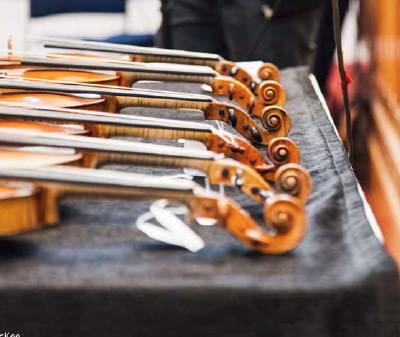Notable Sales: Giovanni Francesco Pressenda
Giovanni Francesco Pressenda is considered to be one of the greatest violin makers of the 19th century, and the father of the modern Turin school. The once-popular theory that he was a pupil of Storioni is not borne out by a comparison of their work, and it is highly likely that he was trained in one of the French run workshops in Turin in the early 1820s.
Pressenda’s early instruments show a strong French influence, and follow the Stradivari model that was so popular in France in the early 19th century. Indeed, the 1827 violin is not at all dissimilar to the instruments emanating from the Vuillaume and Gand workshops in Paris at that time. From 1830 Pressenda’s personality begins to take the upper hand, and his characteristic long f-holes begin to appear, along with the deep red varnish that is characteristic of this period (see the 1834 violin). The strong scribe line on the centre ridge of the scroll is also a common feature; this became a trademark of the Turin school right through to the 20th century. In the late 1830s Pressenda was assisted by Giuseppe Rocca, as is demonstrated by the existence of two practically identical violins dated 1839, one bearing Pressenda’s label and the other Rocca’s.
The two cellos illustrated are based on rather different models, the 1845 instrument drawing much from Guadagnini, and the 1854 cello showing more similarities to Pressenda’s own violin forms.
Pressenda’s most famous pupil was Giuseppe Rocca, but the maker who was most influenced by him was Annibale Fagnola, who copied his work prodigiously. The violin of 1925 and violin of 1932 are two good examples of Pressenda-model violins made by Fagnola.
(b Lequio Berria, nr. Alba, 1777; d Turin, 1854)
Giovanni Francesco Pressenda is considered to be one of the greatest violin makers of the 19th century, and the father of the modern Turin school. The once-popular theory that he was a pupil of Storioni is not borne out by a comparison of their work, and it is highly likely that he was trained in one of the French run workshops in Turin in the early 1820s.
Pressenda’s early instruments show a strong French influence, and follow the Stradivari model that was so popular in France in the early 19th century. Indeed, the 1827 violin is not at... Read more
26 April 2021 - Dilworth, John
The Evolution of Violin Making from 16th-20th Century Part VI
We offer buyers and sellers a bespoke private sale service, sourcing exceptional instruments and bows and matching them with the most discerning buyers.
More InformationTim Ingles and Paul Hayday will offer an initial evaluation of the authenticity and value of your instrument or bow to recommend an auction estimate and reserve price.
Enquire
Tim Ingles and Paul Hayday will offer an initial evaluation of the authenticity and value of your instrument or bow. At this stage, the assessment is free and without obligation. In the first instance, we suggest submitting good-quality images to us, preferably by email to info@ingleshayday.com or by completing the valuation form.
Read more